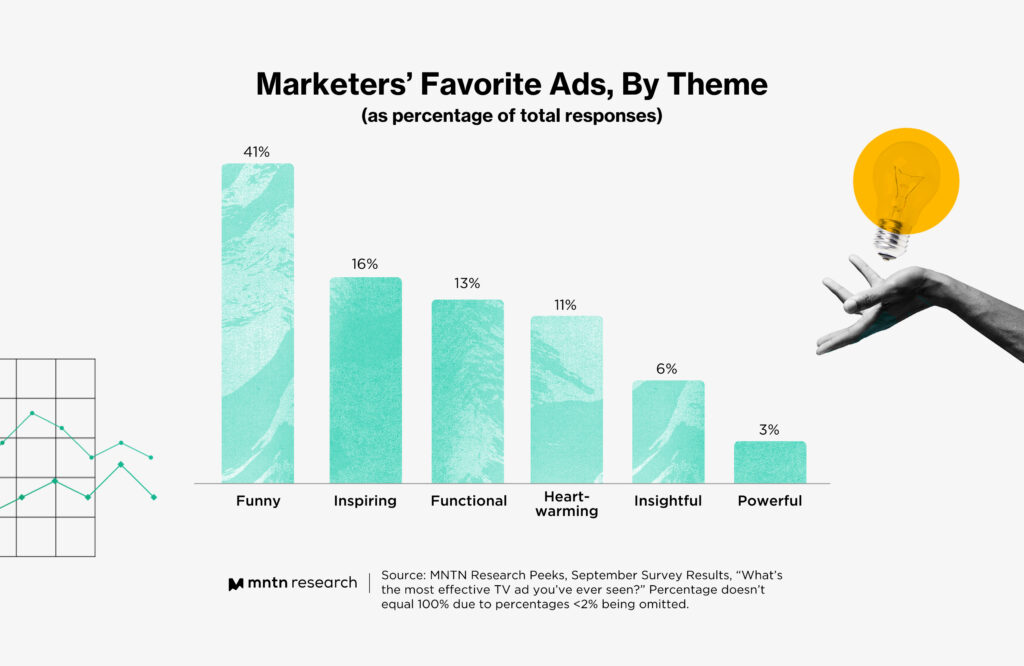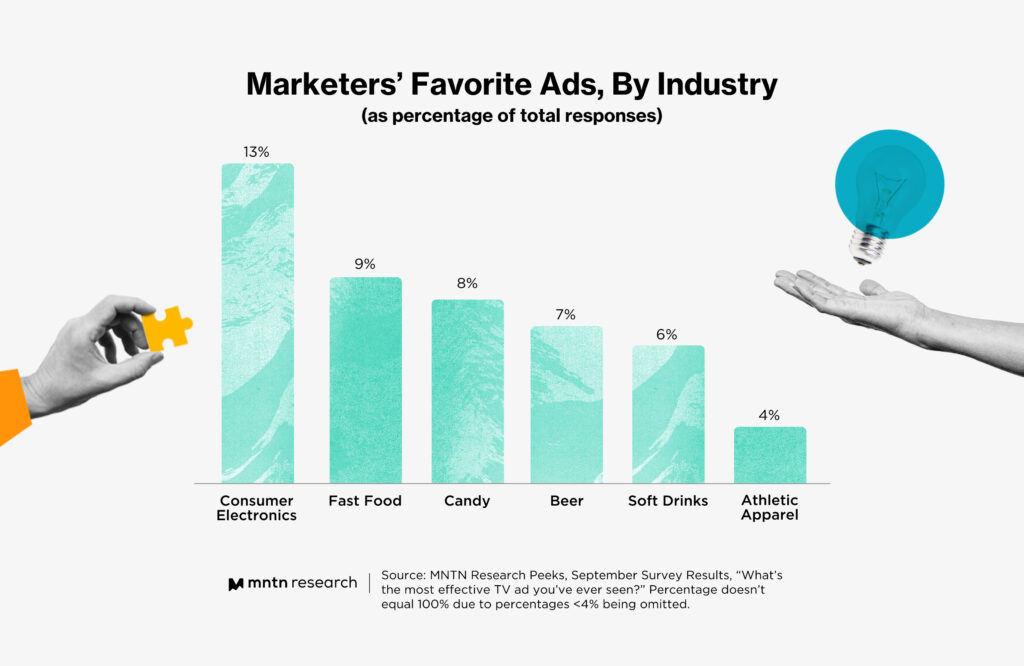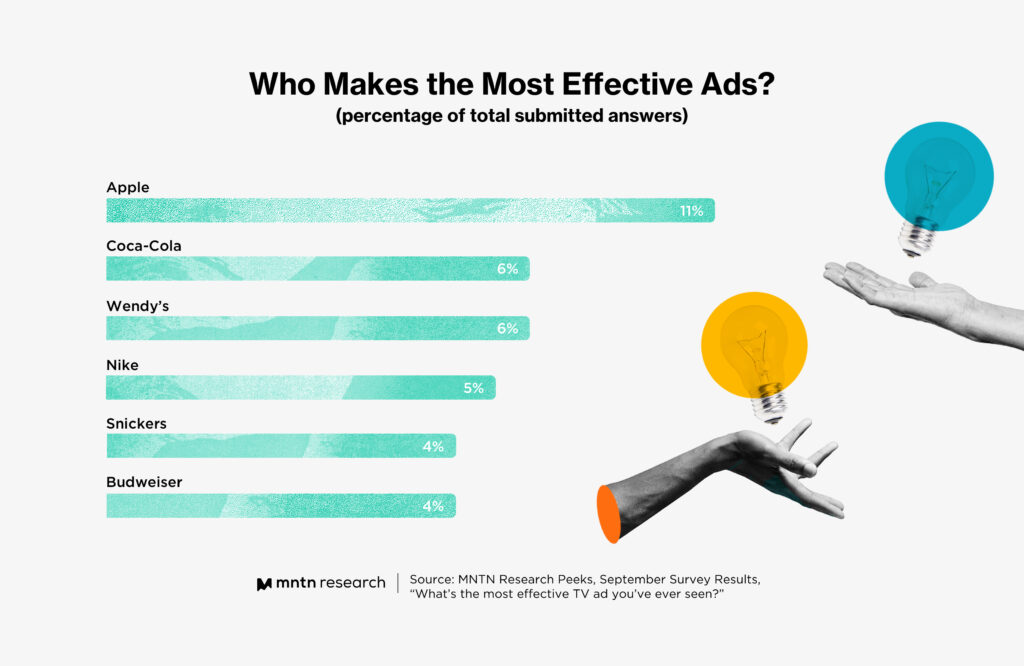Peeks Report
What’s the Most Effective TV Ad You’ve Seen, and Why?
by Tim Edmundson9 min read
Abstract
- We asked marketers to tell us which TV ad they saw as the most effective of all time and to give us a reason why.
- Funny ads accounted for 41% of total answers and ran away with the number one spot for the most common theme. Inspiring (16%) came in a distant second, with a somewhat surprising theme of functional (13%) coming in third.
- Marketers were big fans of ads coming from consumer electronics, fast food, and candy brands, with these top three accounting for nearly 30% of all answers.
- Ads with celebrity cameos accounted for 14% of responses, with Betty White grappling with an NFL star for the title of most-mentioned.
- Industry heavyweights like Apple and Nike were well-represented, but a burger ad from the 80s claimed the number three spot for most commonly cited ad.
What Marketers Think Makes for a Memorable Ad
As marketers, our thoughts on ads and their associated elements (taglines, CTAs, etc.) can be influenced by our profession. When you see a new ad stream across your TV screen, there’s a greater-than-zero chance you’ve uttered professional praise — “that was pretty clever!” — or scorn — “what the hell were they thinking?”
With this in mind, we felt it would be an interesting experiment to collect a wide range of marketers’ professional opinions. The answers could help marketers better understand how their peers (and competition) think about the fundamentals of what they do.
So we asked marketers a simple question: What’s the most effective TV ad you’ve ever seen, and why?
We received a wide range of answers. We pulled them apart to find common threads and outliers, then put them back together again. Here’s what we found.
It’s Funny Which Themes Were so Dominant
As we’ve touched on in a previous Video Vitals report, emotions can have an outsized impact on viewers. Even more outsized? Humor. It turns out, marketers just love to laugh.

If you have 15 or 30 seconds to make an impression, make ‘em laugh. If you lack the ability to do that, inspire them. And if you can’t do either, we’re very sorry. But also, we have good news: focusing on the functional is also very effective.
By functional, we mean being very direct in showing the product, how it works, and why it’s useful. Sometimes that’s all it takes to leave a lasting impression. In fact, there’s a case to be made that a functional approach can elevate your ad and have it compete with the slickest brands out there.
Respondents who nominated functional ads included those from brands such as chemical manufacturers, soap, hardware/home improvement, and medical equipment. That’s right—out of every TV ad ever made, a functional approach led a marketer to name a medical equipment ad as the most effective. That is delightfully remarkable.
As for the rest, here’s a breakdown of which industries most commonly utilized each theme.
- Funny: Fast Food, Beer, Candy, Alcohol, Food & Beverage, Insurance
- Inspiring: Athletic Apparel, Consumer Electronics, Soft Drinks, Skincare
- Heartwarming: Technology, Soft Drinks, Food & Beverage
- Insightful: SaaS/B2B, Office Supplies, Shipping/Logistics
- Powerful: Consumer Electronics, Fashion
Before we move on to our next section, we want to share our personal favorite for an ad that dominated the “funny” category. Meet Dr. Rick.
Progressive’s “Dr. Rick” ads on how not to become your parents when becoming a new homeowner. Hilarious and relatable—my wife and I quote it all the time as an inside joke and also have told others about it. Which in turn resonates with them when they see it. Making it fun will mean people want to share it and you get more awareness and results plus a positive fun image.
Derek Evans, Progressive Insurance “Dr. Rick”
Which Industries are Making the Best Ads?
There’s nothing too surprising on the list of industries producing the most effective ads. If you asked a marketer to guess which types of brands would be well represented, it’s likely they’d name more than a few listed here.

So if we dive deeper into the data, what does it tell us?
- You can split these results into two different camps—one where a variety of brands contributed, and one where a single brand dominated the responses (we’ll get into those a bit later).
- Fast food, candy, and beer had a collection of brands mentioned. Consumer electronics, soft drinks, and athletic apparel were dominated by single brands.
- Case in point: consumer electronics claimed 13% of the total responses. But if you remove Apple, it drops down the rankings. So they’re not only an industry heavyweight in sales, but also in terms of compelling commercials.
Consumer electronics ads leave their mark if they inspire thoughts of change. Fast food brands succeed if they make their food look enticing and pair it with humor. The same can be said with candy, especially during the holidays.
The uniformity in the submitted descriptions suggests that viewers expect a certain type of messaging for certain types of brands. This may seem counterintuitive in an ad landscape where standing out is so important—but that’s what’s fun about the creative process. It’s all about balancing the expected with the exceptional.
Celebrity Sightings
Sometimes a little star power can go a long way. Celebrities were mentioned in 14% of total submissions and were prominent reasons as to why those specific ads were memorable.
Here’s the full list of the celebrities mentioned:
- Betty White
- Mean Joe Greene
- Matthew McConaughey
- Serena Williams
- Ryan Reynolds
- Nick Cannon
- Peyton Manning
- Colin Kaepernick
- Natalie Portman
- David Harbour
Out of every celebrity listed, heavyweights Betty White (of Snickers) and Mean Joe Greene (of Coca-Cola) battled it out for the most mentioned amongst our submissions.
The Betty White Super Bowl ad will always hold a special place in my heart. You know it’s a good ad when you can re-use the concept and it is effective every time.
Kate Underys, Snickers “You’re Not You When You’re Hungry”
It was one of the first TV ads…where the product was a part of the story, but it didn’t press in-detail the features and/or benefits of the product. It helped change industry perceptions of what a TV ad could be.
Matthew Quint, Coca-Cola “Have a Coke and Smile”
And before we wrap up the celebrity section, we can’t go without giving an honorable mention to MNTN Chief Creative Officer Ryan Reynolds, who was cited for his ad work with Aviation Gin.
The Top Brands
When you think of great ads, a few different brands tend to come to mind—and many of them made the list of top mentions.

Surprise, surprise, Apple tops the list for most effective TV ads. One part tech company, one part marketing dynamo, Apple has left an impression on marketers and consumers alike. Interestingly enough, for a brand that has produced countless TV campaigns over the years, all but one of the submitted answers referenced a single ad: the 1984 Macintosh Super Bowl commercial.
It defined the vision of the brand and created an enduring identity.
Ed Mizzell, Apple “1984”
Nike on the other hand included a mix of different campaigns, from the debut of their timeless “Just Do It” slogan to more recent campaigns with sports stars who have made a difference on and off the field. As one marketer put it, “Nike’s commercials sell a feeling, not a product.” And this feeling has been leaving an impact across every campaign they’ve launched over the years.
The original “Just do it” ad in 1988. 34 years and billions of dollars later, it still captures the emotional essence of the sporting category, and has been an extremely wide vessel for brand communications ever since.
Anonymous, Nike “Just Do It”
This ad confirmed that we should keep going even if our ideas/dreams were crazy because perseverance and resilience are so incredibly important in getting through this life. It let us know to never give up hope as a woman, person of color or just being different. The campaign was well done all around.
Ariana Silva, Nike “Dream Crazy”
The third entry on our list proves the power of a one-hit-wonder. The famous “Where’s the Beef?” ad accounted for 100% of answers referencing the Wendy’s fast-food chain, proving it not only made an enormous impact back in 1984 but also 2022. The catch phrase was such a hit it was even referenced in a debate for the 1984 democratic presidential nomination by Walter Mondale.
Wendy’s comes to the rescue with a bun loaded with never frozen beef. The phrase became iconic as well as the unlikely spokeswoman.
Nancy Ward, Wendy’s “Where’s the Beef?”
What’s the Word?
We quantified all the adjectives and adverbs from each answer, and mapped them out. Comedy-related keywords were very common in the received responses, with “humor” and “funny” leading the line. Major advertising events like the Super Bowl (sorry, some nouns slipped in too) also proved effective at making memories.
Above all the rest, “brand” and “product” were most common which makes sense as these two are the foundations of advertising. If you’re looking at what makes an ad effective at the absolute top level, it’s the prominence of the brand and what they’re selling.
Notably, you’ll see in the blue-colored words above a common thread—emotion. Just another reason why making an emotional connection with the audience is paramount in advertising.
The Ads Too Unique to Leave Out
These don’t have a common thread to bind them together with any of the other areas we’ve covered, but for one reason or another, we felt compelled to share.
Crazy Eddie
When assembling our celebrity sighting section, one name popped up on the list that probably shouldn’t have been there—Crazy Eddie. In fact the spokesperson in the ad isn’t Crazy Eddie at all, but a local radio DJ. But the story of the man behind it is too scandalous not to share. Crazy Eddie, co-founded by Eddie Antar, was a successful electronics retailer based in the northeastern US during the 1980s. Their ads embodied the high-energy, frenetic style that has come to dominate local TV ads for seemingly generations.
Much like the tagline, “His prices are insane!”, so too is the ultimate fate of Eddie Antar. Shortly after the sale of the company to a group of investors in 1987, it was revealed “His business practices were insane-ly fraudulent!”
Antar fled the country but was extradited back in 1993 to stand trial. After a years-long legal drama, which saw his original fraud conviction overturned, he eventually pleaded guilty and served time before being released from prison in 1999.
Needless to say, this story, while serious and tragic, does lend a bit more mystique to the insane local retailer trope. In fact, we’ll be diving into local TV advertising more in a future topic because Crazy Eddie really is just the tip of the iceberg when it comes to these ads.
The World’s Most Annoying TV Ad
There’s something to be said for ads that leave a lasting memory despite how much you would prefer they didn’t. This submission for Australian retail department store chain JB Young’s was the only one that led with “annoying” as the primary reason why it was the most effective, and we have to agree.
Unfortunately because the ad is so annoying—we’re pretty sure that’s the reason, anyway—we couldn’t find it hosted anywhere we could embed the video. So we’re linking to it here. Give it a watch, and you’ll be asking “Wheeeeere d’ya git it?” just like the rest of us.
“One of the Highly Contested, Horrifying, Hilarious Ads of All Time”
With a quote like that, we simply could not help ourselves from including this one. The Quiznos “Spongemonkey” campaign, where animal-like(?) puppets(?), play guitar and sing(???) about how great the sandwich chain’s subs taste certainly lives up to the billing found in the submission. The marketer who sent this one chose to remain anonymous—watch the ad and draw your own conclusions as to why they decided to not attach their name to this.
The Most Effective Ads Find Ways to be Memorable
Based on the submissions we received it’s clear that what makes for an effective ad can be somewhat subjective. If the Quiznos “Spongemonkey” ad can stand shoulder to shoulder with Apple’s “1984” then that should tell you something about how effectiveness is truly in the eye of the beholder.
That said, each TV commercial submitted does have a common thread that binds them all together. They all manage to set themselves apart by doing something particularly well. They found a hook, be it funny, inspiring, or functional, and then injected their brand’s vision, voice, or value. Their message was woven into their creative approach, providing us with a rough formula of hook + message = effective.
This may sound like the basics of advertising because, well, it is. It’s the fact that these brands locked in their fundamentals, then executed effectively that made them stand apart. So if there’s anything to learn from all this regarding a way to make an effective TV ad, it’s doing just that.
And also, make it funny.
Subscribe to the MNTN Research Weekly
Sign up to receive a weekly feed of curated research, sent straight to your inbox.